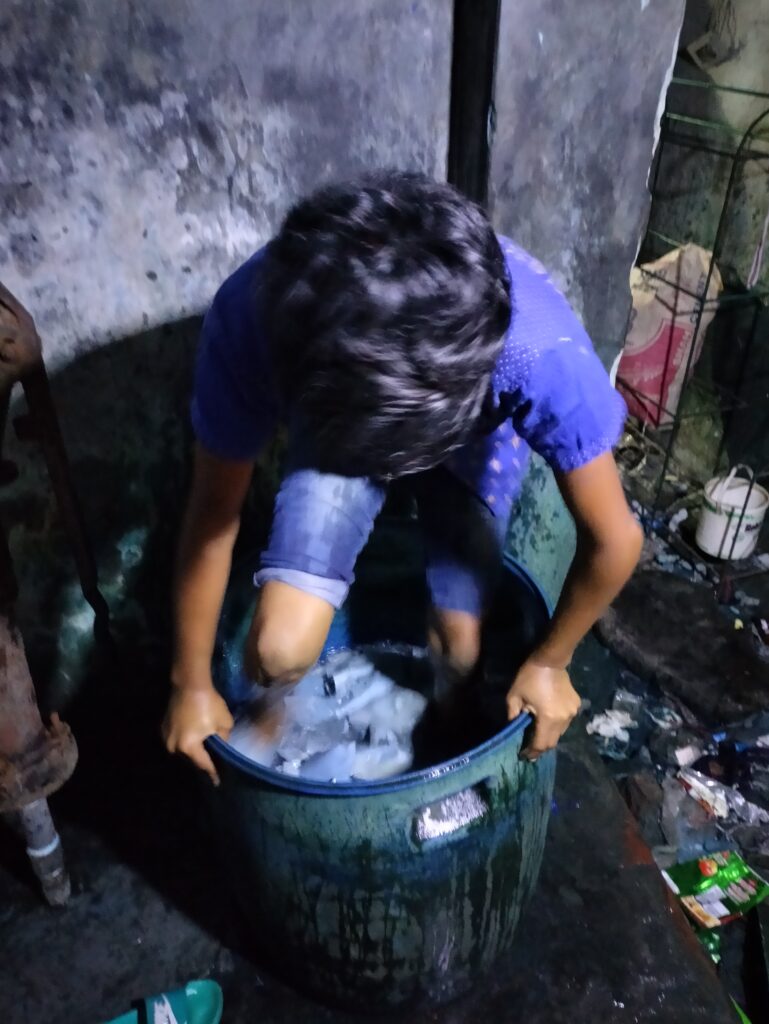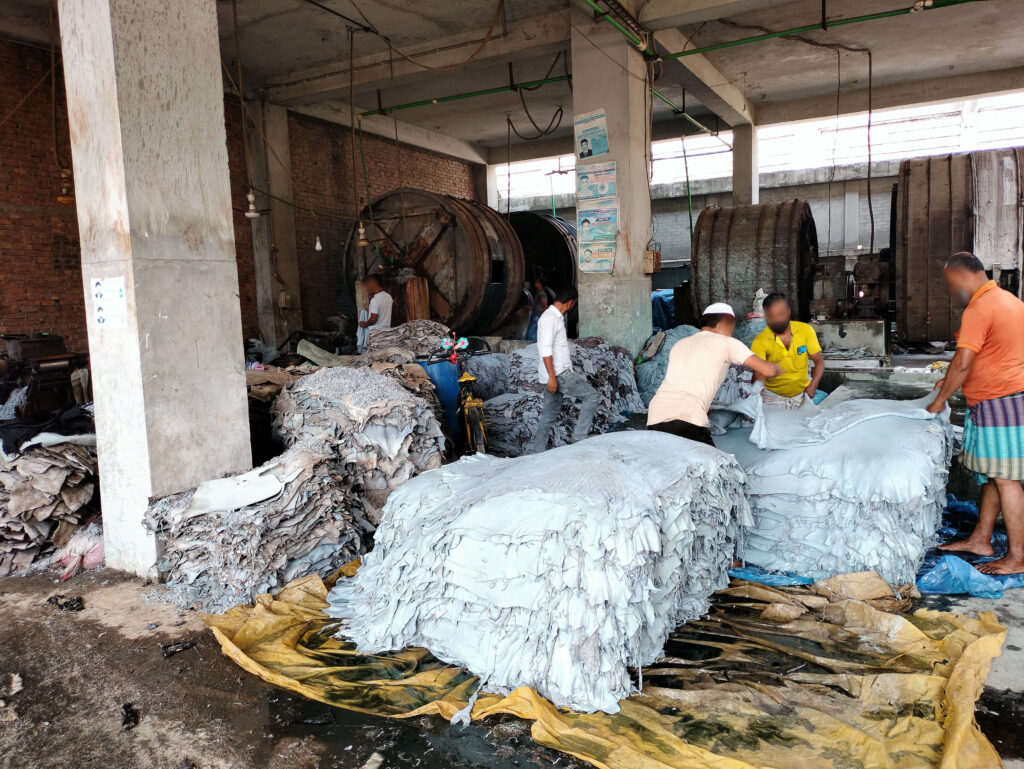Exploring the hidden presence of sex work in a Kathmandu Khaja Ghar
The realities of running a khaja ghar in a major transport hub in Kathmandu
Introducing Punam and her khaja ghar
Small-scale khaja ghars (snack shops) are ubiquitous in neighbourhoods across Kathmandu. Most khaja ghars offer a range of snacks, such as chow mein noodles and barbequed meat dishes. Some offer chiya (Nepali tea), whereas others sell alcoholic drinks, including rakshi or tongba (types of local homemade alcohol – the sale of which is illegal). Khaja ghars are usually run by a female owner, with the support of family members and/ or one or two employees. While khaja ghars primarily provide snacks and drinks to customers, there is a diverse range of these eateries in Kathmandu. In areas where there are high levels of footfall and transient custom, some khaja ghar establishments are involved in facilitating sex work.
Punam (name has been changed) runs a khaja ghar 300 meters from Kathmandu’s main bus park: a huge transport depot with buses constantly arriving from and departing to districts across the country. It is the main drop-off point for migrant workers traveling from different districts of Nepal on their way to take up jobs overseas, or returning to visit family and friends having worked, usually for several years, abroad. The area has a vast array of services to cater to the needs of those traveling to and from the capital, including guest houses, restaurants, sweet shops, mobile phone shops, dance bars and khaja ghars. The area straddles Kathmandu’s ‘ring road’ – a large highway circumventing the city. As a result, the area feels particularly polluted and dusty. In the khaja ghar’s immediate vicinity there are guesthouses, government offices, a school, a recruitment company (which recruits individuals for foreign employment), and another khaja ghar. The location is good for Punam’s business because customers visit from the guest houses nearby, which tend to provide accommodation without serving food.
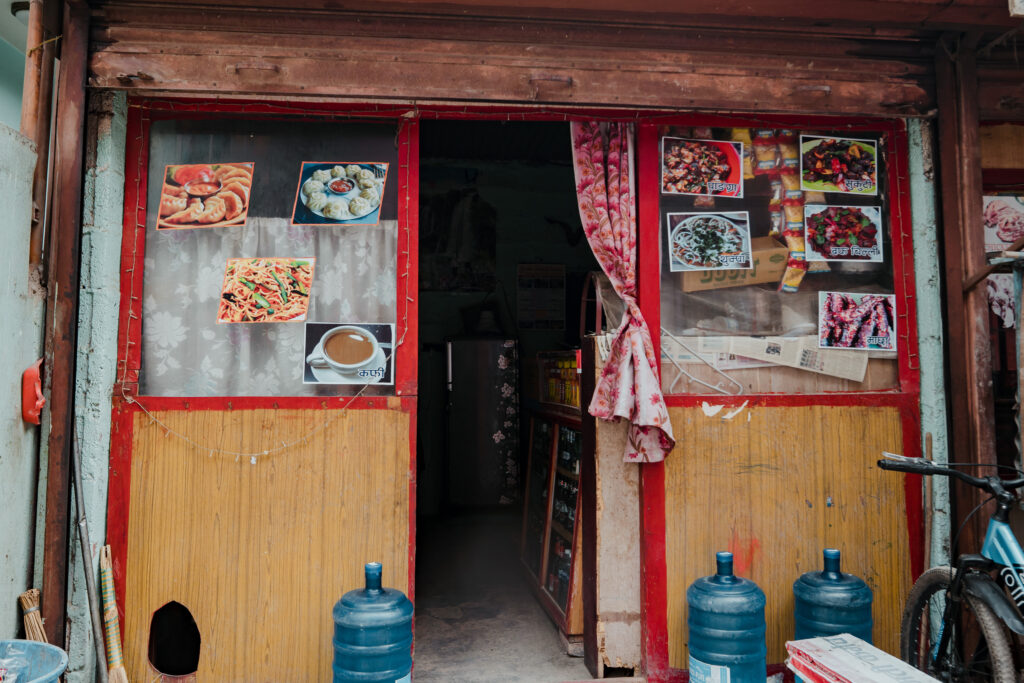
The shopfront of the khaja ghar (snack shop).*
Punam’s khaja ghar is less than 500 square feet and comprises two small rooms. On entering the khaja ghar, the first room has a cooking area with a two-burner stove on one side of it and two small dining tables on the other side. Dried meat hangs above the cooking area. The second room is situated behind the first; here there are two more dining tables and a bed, where Punam’s brother-in-law sleeps at night (sometimes joined by her father, who lives nearby). Customers visiting the khaja ghar tend to prefer sitting in this second room, because it is more private.
The khaja ghar is dark inside and is poorly ventilated. There is no hygienic space for food preparation, and the facilities are simple. For example, there is no running water for washing dishes. The food available includes dried meat dishes, chow mein, momo (a type of dumpling), chicken gizzards, and spicy meat dishes.

The main dining room and kitchen area
Punam is 34 years old. She completed her education up to grade 12 (higher secondary education). Punam lives with her husband, her ten-year-old daughter, her husband’s brother (who is in his mid-twenties) and her husband’s sister Kushum (who is 17 years old). They live in a rented flat with two rooms approximately half an hour’s walk from the khaja ghar.
Punam has been running the khaja ghar for five years. Her husband and brother-in-law work at the khaja ghar and Kushum provides support when not at school. Punam says that she allows her to choose when she wants to work. Her husband makes the food while her brother-in-law undertakes various tasks including cooking, preparing food and serving customers. Punam mainly serves customers but also cooks.
Her brother-in-law does not receive a salary; instead, Punam covers his living expenses. She also employs one female (in her 30s) daily to wash dishes.
The business is not registered with the relevant government authorities.

Private room containing two more tables and a bed with a blanket and fan on top of it
Kushum (17 years old)
Kushum’s brother brought her to Kathmandu from their remote village in Western Nepal after she had completed her grade 10 exams the previous year. She is studying for her higher secondary education certificate and attends school in the mornings. A local NGO and her brother cover her education costs. After returning from school, Kushum says that she often works ten-hour days in the khaja ghar. She is not paid for working in the khaja ghar but her brother and Punam cover her living and education expenses. She came to Kathmandu to help her family run the khaja ghar and further her education in Kathmandu. She aims to go abroad to work in the future.
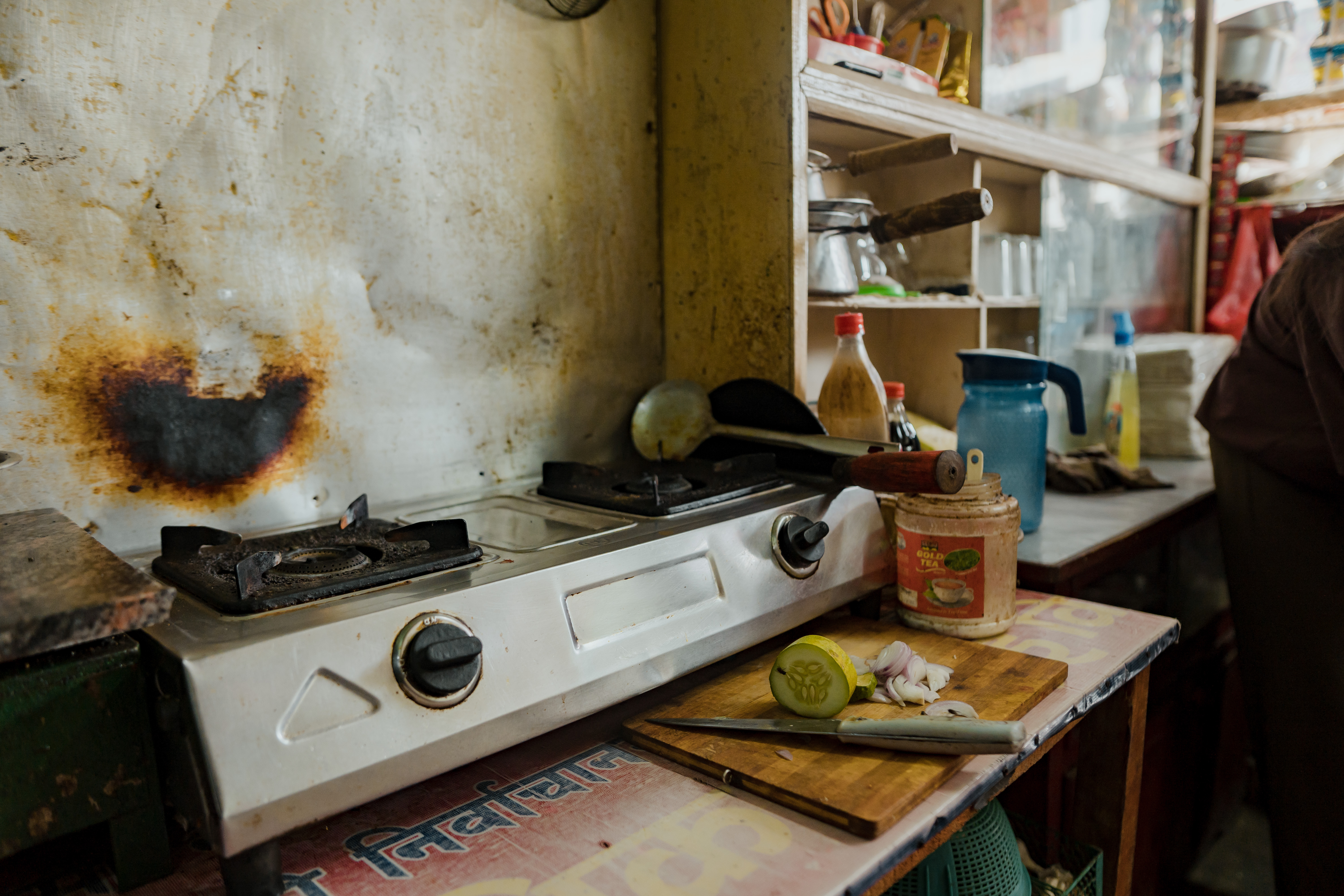
Accompanying Punam at work
In November 2022, three CLARISSA researchers (one male, two female) accompanied Punam for two days to observe in detail the day-to-day realities, practices and pressures of running a khaja ghar. The workday started at around 8am and finished in the evening at around 8pm. Researchers accompanied Punam for ten hours each day.
Punam is part of a CLARISSA action research group made up of khaja ghar business owners. The trust already established between researchers and Punam through being involved in this group was helpful and allowed them to feel comfortable in each other’s company.
During the accompaniment, observations about the business, its environment, its workers, its services and customers were shared between the researchers using a mobile phone messenger app. This allowed observations to be noted down by researchers without it looking like they were recording, which would have been disruptive to customers. At times the researchers asked Punam questions to understand what they were observing.
Researchers accompanied Punam, her husband, her husband’s brother and a female employee to learn the work of running a khaja ghar. Two children were also present – Punam’s teenage sister-in-law, Kushum, who worked from midday after college, and Punam’s 10-year-old daughter who was present, but not working.
During the research team’s accompaniment, it was clear that Punam’s khaja ghar serves as a meeting point for people. Usually in the mornings, customers from nearby guest houses, which don’t provide food, visit the khaja ghar for tea. These guests are mostly migrant workers traveling overseas or returning from abroad from foreign employment. Twenty customers were observed during the two days of work shadowing: 13 customers on the first day (between 9:30am and 8pm) and seven customers on the second day (between 7.30am and 5.30pm). On the first day, this included three teenage boys, seven men and three women. On the second day, there were three teenage boys, two men and two women.
What happened at the khaja ghar
Day one
The khaja ghar is usually opened at 5:30 am either by Punam’s brother-in-law or husband. On the first day, Punam’s brother-in-law opened up and Punam and her husband arrived at around 8.30/ 9am after getting their daughter ready for school. During the daytime, Punam and her brother-in-law worked together, sharing the tasks of cooking and serving customers equally. Kushum arrived at around mid-day having finished college. A female employee in her 30s, who is hired to wash dishes, worked at the khaja ghar from around 9am to 5pm. This female employee told the researchers that she is provided with one meal a day and receives a daily wage of 200 NPR (less than US $1.50). She herself once owned a khaja ghar (and is also a member of the CLARISSA khaja ghar owner action research group). After this employee left, the task of washing the dishes was taken on by other family members.

Fewer customers visited the business than usual. Whilst Punam says that she has a good number of regular customers, there were less than usual due to it being election time.
A male and female customer visited the khaja ghar at around 8am to consume local home-made alcohol. A group of adolescents (predominantly male and aged under 18) also visited the khaja ghar in the early morning. The group stayed in the khaja ghar for several hours, drinking tea and eating. They prepared cigarettes containing marijuana, which they smoked some distance away. The teenagers kept to themselves and did not disturb other customers. Punam allowed them to prepare their cigarettes. She did however suggest several times to them that they should not smoke marijuana because of its ill effects on their health.

At around 9am, two women aged around 30 years old came to the khaja ghar with a man who was in his 60s. Punam told the researchers that these women are involved in sex work with rich customers. Punam explained that while they undertake sex work with rich customers themselves, they also play the role of broker for ‘low-income’ customers, making arrangements between these clients and other individuals involved in the provision of sexual services. The man they were with was a wealthy local resident, from a well-to-do family.
The trio sat together playing ludo on their mobile phones until the afternoon. They bet a small amount of money on each game, and the winner gave 10 NPR (less than US 10 cents) to Punam each time – a small charge for allowing them to play on her premises. While they played, they ordered food as well as soft drinks and alcohol – the costs of which were covered by the man. Whilst they were playing ludo in the back room, one of the researchers passed them on the way to the khaja ghar’s rest room and saw the man engaging in a physically intimate act with one of the two women.
At one point, the man requested that the female employee who washed dishes sit with him. She ignored this request. The man then enquired about her husband and asked her what was different that day, as she would normally have come to sit with him. It seemed that she may have been influenced by the presence of the researchers in choosing not to sit with the customer that day.
Punam’s ten-year-old daughter arrived at the khaja ghar after school, at around 4:30pm. She spent her time eating snacks, painting and speaking with the researchers. She was familiar with the male customer and they spoke with each other in a familiar way.
In the evening, several men (in their 40s) visited the khaja ghar individually, primarily for alcoholic beverages and meat dishes.
The business remained open until 9pm. After closing up, Punam and her family had dinner in the khaja ghar before going home.
Day two
On the second day of accompaniment, researchers joined Punam at the khaja ghar at around 7:30am. The same group of adolescents visited the khaja ghar and again, sat talking and preparing their marijuana cigarettes. At around 9am the two women returned and were joined by the man in his 60s. They again sat together playing on their mobile phones until the afternoon.
Punam’s daughter was at the khaja ghar the whole day because there was a school holiday. One of the researchers sat with her outside the khaja ghar helping with her painting. She loves painting and she also goes to karate classes. The way she talked with some regular customers gave the impression that she is very familiar with the khaja ghar environment. She talked with customers who were regular and familiar to her.
A man in his 30s (a new customer) visited the venue in the early afternoon. He ate some snacks and then left the venue. He then returned to the khaja ghar and sat down and then left and returned several more times. The researchers felt that the customer had assumed that they (the two female researchers) were employed by the khaja ghar for sex work.
Like the previous day, in the evening, several men visited the khaja ghar to eat meat dishes and drink alcoholic beverages.
Punam’s relationship with customers
Punam generally treats customers politely, whether they are one-time customers or visit the khaja ghar frequently. She is not overly familiar with her regular customers, but keeps a distance between herself and her family, and those frequenting her business. Over the course of two days, Punam was not observed sitting or chatting in a relaxed way with customers. Her family is closely connected to the business, and her ten-year-old daughter spends a lot of time at the khaja ghar when not attending school. Perhaps because of this, Punam seemed cautious while dealing with customers. During conversations with the researchers, she said that in the early days of running her business, she was scared of being there alone, and preferred a male family member to accompany her at the venue.
Punam has concerns about some customers. This includes a teenage girl who accompanies the teenage boys for tea and is engaged in dealing drugs. Punam worries about the involvement of the teens in drug dealing, particularly as disputes over drug deals exposes them to violence or death threats. Although Punam is not directly involved, she is concerned for the young people’s wellbeing. Punam says a girl aged under 18, who she describes as being involved in providing sexual services, visits the khaja ghar to try to find customers. Punam explains how she has to tell her off when she feels that the girl is harassing customers (for example, when she sits on their laps). Punam says she does not want this type of behaviour exhibited in front of customers or her family.
The economics of the khaja ghar
Punam takes between 3,000 and 9,000 NPR (US $20 to 70) per day at the khaja ghar. On the first day of accompaniment, she earned 3,700 NPR (around US $30).
Punam’s main monthly expenses are 17,000 NPR (US $130) for the khaja ghar’s rent and 9,000 NPR (US $70) for the room where she lives with her family. She acquired the khaja ghar as an ongoing concern for around 200,000 NPR (US $1500) and invested an additional 84,000 NPR (US $640) in it when she took it over. She has a loan of 200,000 NPR (US $1,500) which she repays in installments. To ensure that she can pay the rent each month, she saves 1,000 NPR (US $7) per day.
This business is Punam’s only source of income. She uses the takings to cover all her family’s expenses. She does not maintain an account book to record the takings, costs and profits of the khaja ghar. She seems to have limited financial literacy to monitor expenses, assess the profitability of the business, and plan her future finances.
Aside from the fixed costs of running the business, Punam must regularly buy groceries. In the mornings, Punam purchases vegetables from nearby vendors. Sometimes when she is busy, she calls a vendor to let him know what’s needed and then goes to collect the ordered vegetables later that day. Sometimes the vendor includes slightly damaged yet edible vegetables free of charge. Punam and the vegetable vendor are of the same caste and are from the same village, so they trust each other. She also buys water jars for her business, which are delivered by a delivery vehicle, and she buys meat, local home-made alcohol, grocery items, cigarettes and donuts from informal vendors.
Despite running the khaja ghar business for five years, Punam still uses cash to purchase branded alcohol; because her business is not legally registered, she is unable to purchase on credit. She selects the shop where the alcohol prices are lowest. To purchase local home-made alcohol, Punam travels to a village 5km away. Selling this alcohol is crucial to her business because the profit margin for other food items is so minimal.
Throughout the shadowing exercise, Punam informally shared various observations regarding the khaja ghar next door to hers (the only other khaja ghar in the immediate vicinity). She described how this khaja ghar provides sexual services to customers, ‘young girls’ are hired to provide sexual services, and frequently changed to sustain the business. The girls are offered free meals when they have no money. Punam said that she does not want to compete with that khaja ghar in this way (i.e., by hiring girls to provide sexual services). Researchers asked her about the differences between her khaja ghar and her competitors and she revealed that her husband plays an important role as an intermediary, bringing migrant workers from the hotels and guest houses nearby. This provides a decent flow of customers to her khaja ghar.
She also feels that her good food contributes to her success in attracting customers and that she has a loyal base of regular customers. Punam would like to expand her business by adding a barbeque section but has concerns that smoke generated could be a nuisance for nearby establishments, including the guest houses she relies on for business. She would like to expand her business in a way that does not harm the good relationships she has with other businesses in the locality.
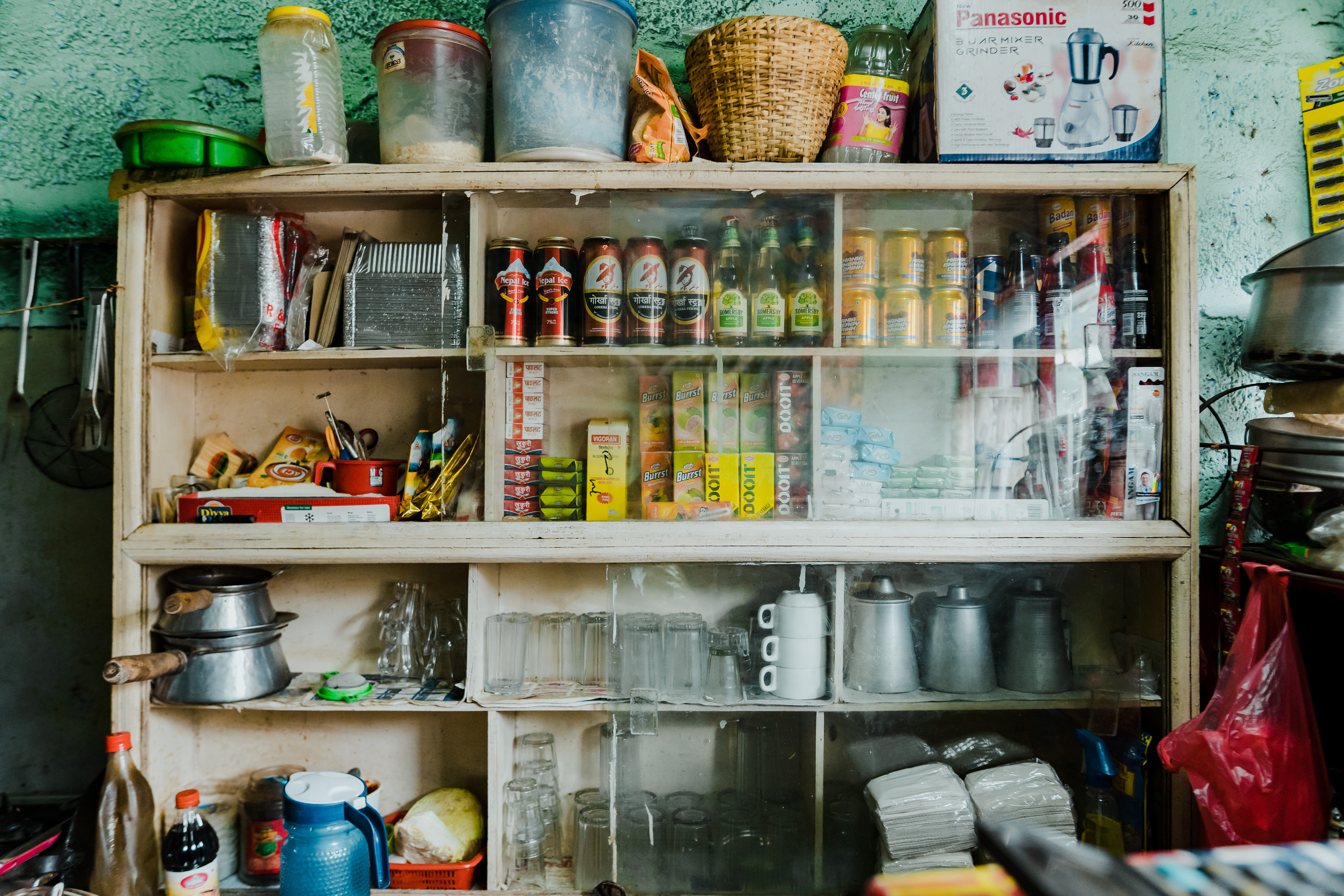
Conclusion
Researchers spent two days with Punam and her family, including two children, in the khaja ghar. The khaja ghar is a place for travelers to eat and drink at relatively low cost, and provides a space for local residents to congregate, meet up and spend extended periods of time. A range of customers (all of whom were Nepalese) of different ages and socio-economic backgrounds were observed.
Punam can earn enough to support her family by running the khaja ghar. The accompaniment revealed some specifics about Punam’s business model that keeps the business operationally viable. Whilst khaja ghars sell food items cheaply, which in turn requires costs to be kept low, her business benefits from good relationships with local vendors and from Punam from shopping around to secure the lowest priced goods, in particular, branded alcohol (which she serves as well as homemade alcohol).
The business also relies on keeping staff costs low: the employee who washes dishes is paid around half the government stipulated minimum wage of 17,300 NPR (US $130) per month, while family members, including her teenage sister-in-law contribute to the business, often working long hours, in exchange for living and/ or school fees costs being covered.
Providing a safe and private space where customers can spend extended periods is important (so customers will come regularly), as is appealing to Nepali travelers at nearby guest houses. Providing home-made alcohol is a further factor that helps sustain Punam’s business because it is the only commodity with a significant profit margin. Punam’s lack of financial literacy and the extremely informal ways in which her business is run make it difficult for her to access credit (e.g., for alcohol) and other forms of support that could enable her to have more oversight of the khaja ghar’s financial transactions and therefore plan more strategically.
Part of the khaja ghar’s appeal seems to be that regular customers can use the space as a home-away-from-home and can therefore undertake activities they need privacy for, whether this is to roll marijuana cigarettes or to be intimate with a partner. The dimly lit back room of the khaja ghar lends itself to these types of activity. In addition, Punam allows these activities to take place at her venue unobstructed and with little comment or intervention. Punam does, however, enforce boundaries when she feels that the activities of her clientele are too indiscreet or are unacceptable. For example, she described how she reprimanded a girl (aged under 18) who she felt was harassing a customer to pay for sex with her. Ensuring that members of her family are not exposed to explicit displays of intimacy seems to structure her decisions on where to enforce boundaries.
Punam differentiates her business from the khaja ghar next door which she feels uses women and girls strategically to increase earnings. Punam’s level of intentionality and relationship with facilitating sexual services appears limited in comparison; customers engaging in physically intimate acts on the premises, or using her khaja ghar as a place to potentially arrange sexual services only brings her indirect benefits (i.e., increased food and drink sales). While Punam is protective of her family members and is critical of the khaja ghar nearby which intentionally uses sexual services (and seemingly, the sexual exploitation of children) to attract custom, the nature of Punam’s set-up means that her daughter and sister-in-law are working or spending time in a sexualised environment, exposed to exchanges/transactions that usually take place in adult worlds. The environment is distinct from a café where individuals go to fulfil their hunger needs; children are in close proximity to customers using the khaja ghar to satisfy sexual needs.
*Photo credit: Anish Bastola. Written consent was provided by the owner.



